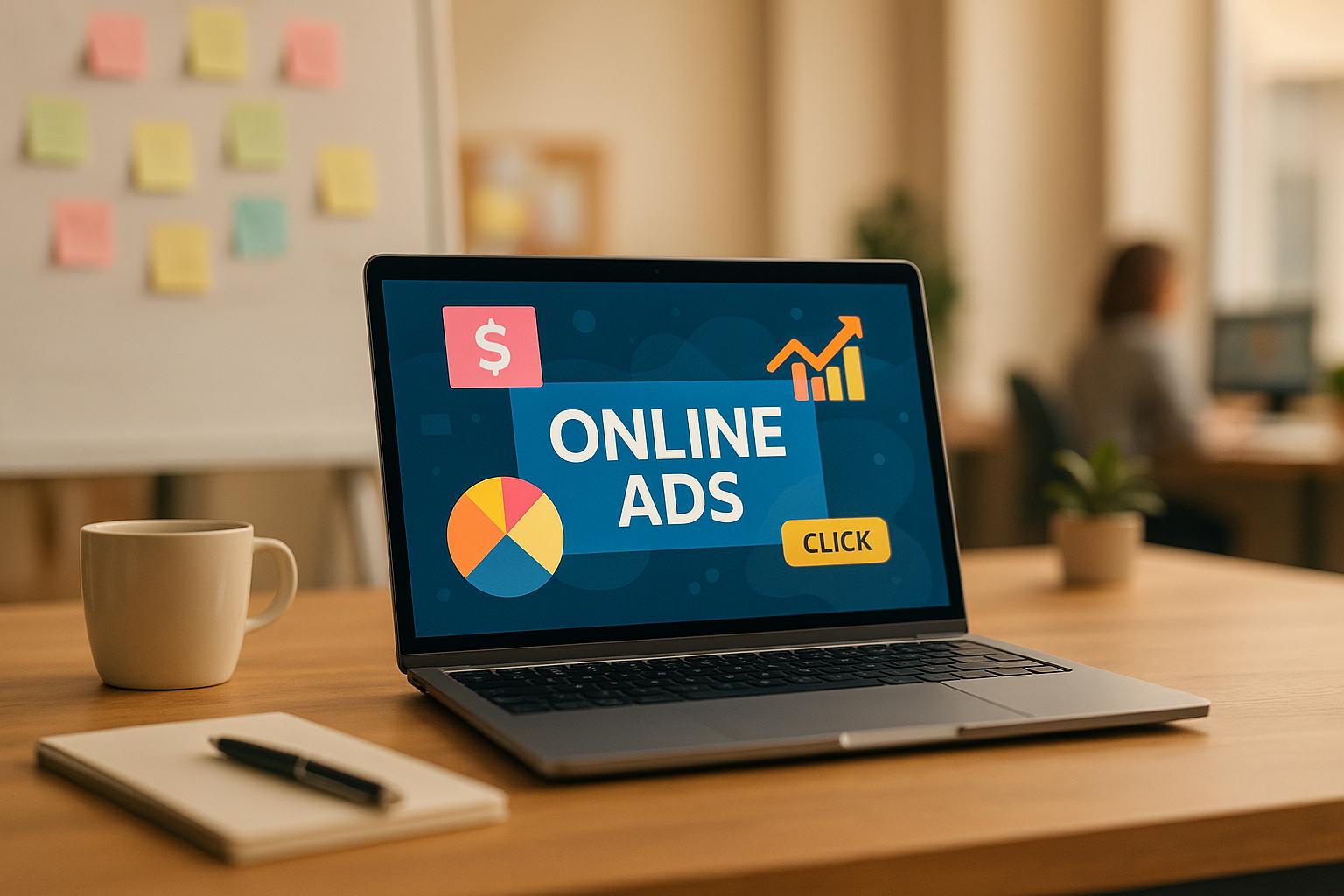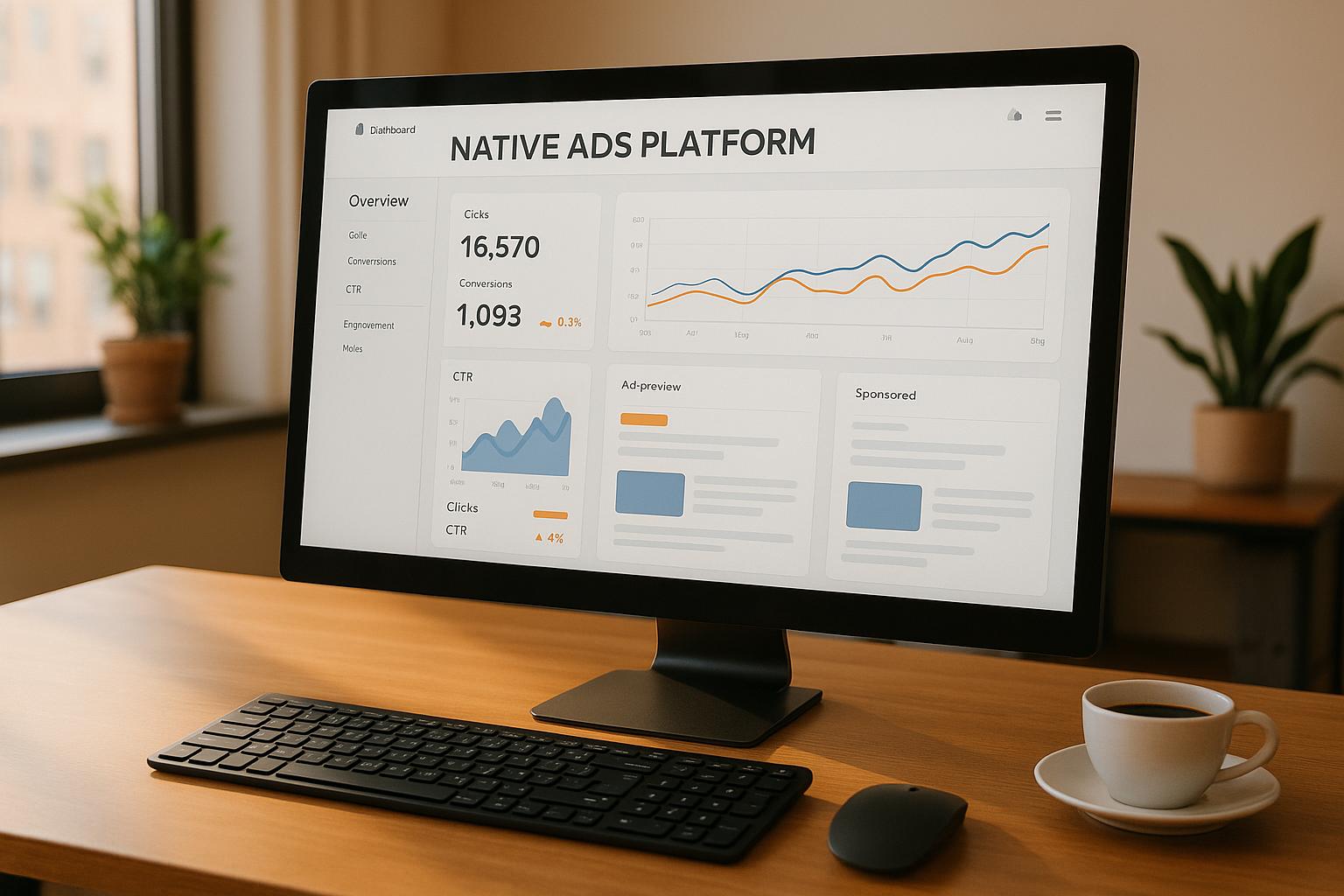Google AdSense is popular, but it’s not perfect. Many publishers struggle with unpredictable earnings, ad blockers cutting revenue, and limited control over ads. If you’re tired of these issues, there are better options depending on your traffic and niche. Below are four alternatives to consider:
- TinyAdz: Great for small or niche publishers. No traffic minimums, personalized ad targeting, and multiple monetization options like newsletters and events.
- Media.net: Focuses on contextual ads with premium Yahoo-Bing network demand. Best for high-quality traffic from the U.S., Canada, and other tier-1 countries.
- Ezoic: AI-powered platform for optimizing ad placements automatically. No traffic minimums and offers tools to boost revenue and user experience.
- AdThrive: Designed for high-traffic sites (100,000+ monthly views). Offers premium ad placements, dedicated account managers, and high CPMs.
Quick Comparison
| Platform | Best For | Traffic Requirements | Revenue Potential | Key Features |
|---|---|---|---|---|
| TinyAdz | Small/niche publishers | No minimum | Competitive for niches | Customizable ads, multiple formats |
| Media.net | Contextual advertisers | Tier-1 traffic (U.S., etc.) | $1–$1.25 CPM+ | Yahoo-Bing ads, sleek integration |
| Ezoic | AI optimization seekers | No minimum (1k+ recommended) | $20–$25 RPM average | AI testing, detailed analytics |
| AdThrive | High-traffic publishers | 100,000+ monthly views | $15–$40 RPM+ | Premium ads, hands-on support |
Each platform has unique strengths. If you’re just starting out, TinyAdz or Ezoic are great options. For established sites, AdThrive offers unmatched revenue potential. Choose based on your traffic, niche, and how much control you want over ad management.
10 Best Google Adsense Alternatives for Publishers in 2024
1. TinyAdz
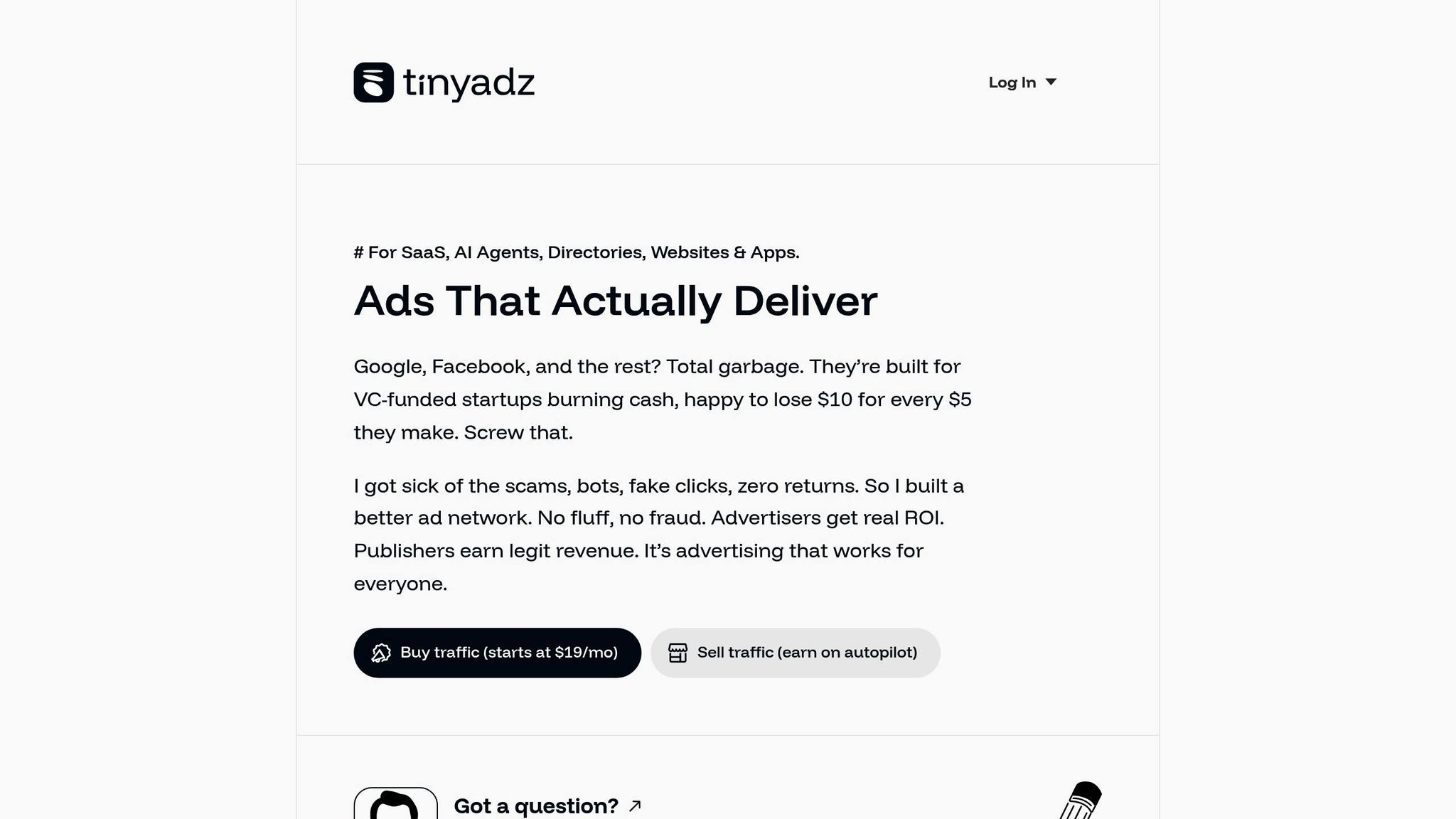
TinyAdz is a platform designed to help small websites and niche publishers monetize their content through hyper-targeted ad solutions. Unlike traditional ad networks that cater to high-traffic websites, TinyAdz focuses on connecting advertisers with smaller, highly engaged audiences. The platform excels at matching ads to the publisher's content and audience for a more personalized approach.
What makes TinyAdz stand out is its dedication to prioritizing quality campaigns and steering clear of spammy links that could harm the user experience. It’s a favorite among SaaS creators, newsletter publishers, bloggers, and directory owners who want to monetize without compromising their brand's reputation.
Revenue Potential
TinyAdz uses a revenue-sharing model that aims to provide competitive payouts for publishers. This model, combined with its focus on niche targeting, often results in higher engagement rates. For publishers with specialized audiences, this translates into better monetization outcomes compared to broader ad networks.
The platform prioritizes quality over quantity, ensuring that ads resonate with the audience. This targeted approach drives higher click-through rates, making it an excellent choice for niche publishers who may face challenges with lower CPMs on traditional networks.
Traffic Requirements
One of TinyAdz's biggest advantages is its welcoming approach to smaller publishers. The platform doesn’t enforce strict minimum traffic requirements, making it accessible to new and niche content creators. This aligns with TinyAdz's mission to support genuine platforms, regardless of their size.
As of April 2024, TinyAdz had partnered with 640 sites, generating 350,000 views and 30,000 clicks. Publishers interested in joining should focus on building an authentic, engaged audience rather than worrying about traffic thresholds. TinyAdz values real connections over sheer numbers.
Ad Customization
TinyAdz offers a variety of customizable ad formats to suit different needs and audience preferences. Options include banners that integrate seamlessly with content, as well as more eye-catching designs for greater visibility. This flexibility allows publishers to select formats that align with their content strategy and user experience goals.
Monetization options include banner ads, directory monetization, traffic monetization, social media, newsletters, and even events. The platform’s personalized matchmaking ensures ads are tailored not just to general demographics but to the specific traits of each publisher's audience. This keeps ads relevant and authentic, which is critical for niche audiences.
Reporting and Analytics
TinyAdz provides publishers with transparent and detailed reporting tools to track ad performance and revenue. The analytics focus on meaningful metrics, giving publishers the insights they need to refine their strategies while maintaining audience trust.
This transparency reflects TinyAdz’s commitment to treating publishers as partners, not just traffic generators. By offering clear insights, the platform empowers publishers to make informed decisions about their ad placements and formats, setting a strong foundation for comparison with other platforms.
2. Media.net
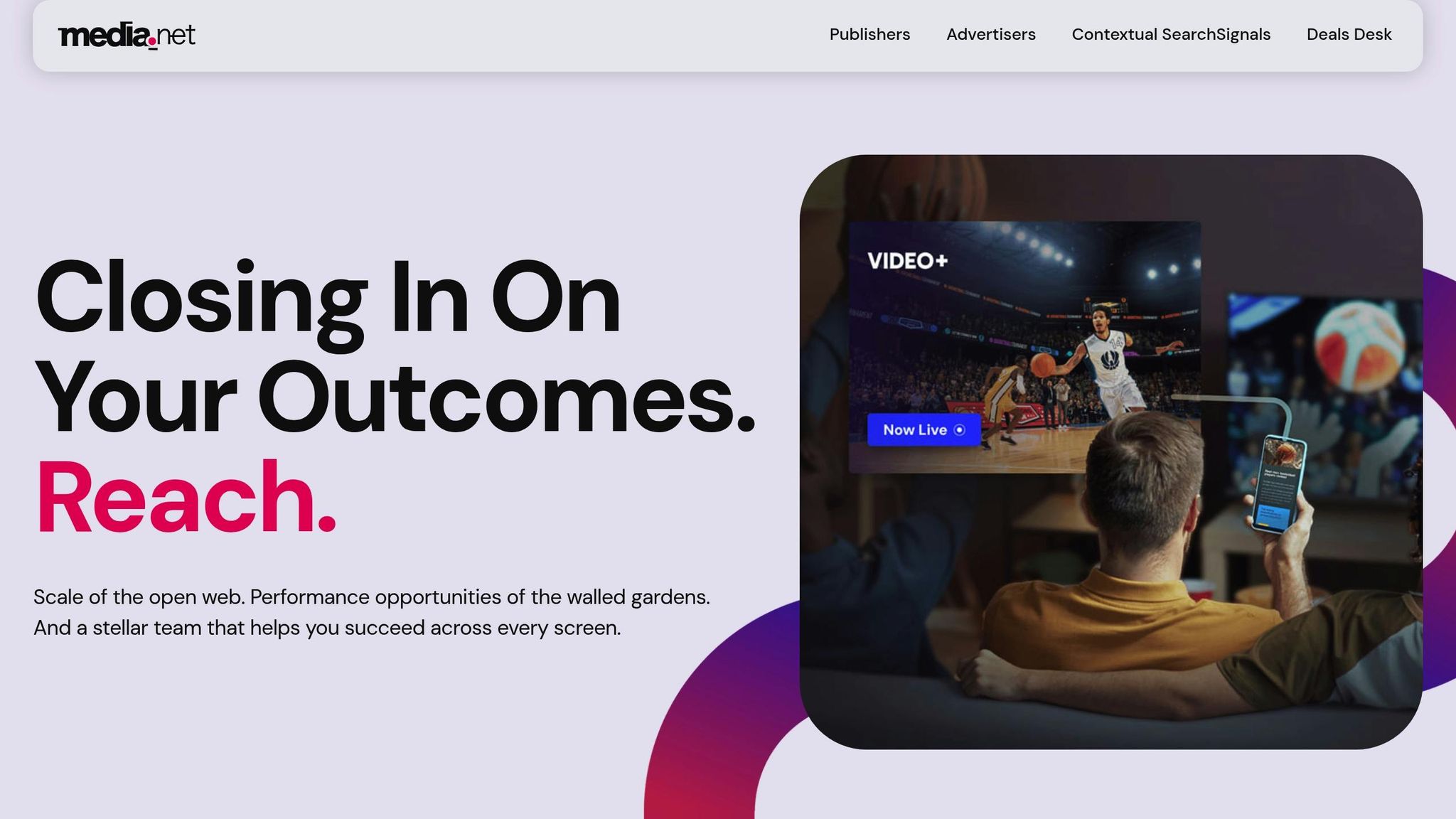
Media.net is one of the largest contextual ad networks in the world, delivering millions of ad impressions across a network of over 500,000 websites. What makes Media.net stand out is its exclusive partnership with the Yahoo!-Bing network, giving publishers access to premium ad demand. The platform uses advanced contextual targeting to match ads seamlessly with website content.
Unlike many ad networks that prioritize traffic volume, Media.net focuses on website quality. This makes it an excellent choice for publishers who produce high-quality content aimed at audiences in tier-1 countries like the United States, Canada, Australia, and the UK.
Revenue Potential
Media.net’s focus on premium demand sources translates into strong revenue opportunities, especially for publishers in high-value niches like finance and technology. The platform offers CPM rates ranging from $1.00 to $1.25, with some niches earning even higher rates.
Payments are processed monthly, with a minimum payout threshold of $100, and all transactions are conducted in USD. However, Media.net does not publicly disclose its revenue share percentage, which can make it harder for publishers to gauge their exact earning potential.
"I use Media.net for contextual ads, which work well for my US and Canadian traffic. Powered by the Yahoo Bing Network, Media.net's ads are highly relevant to the content on my sites and get higher engagement and click-through rates. The network's competitive CPM and sleek and customizable ad format make it a good alternative to Google AdSense." - Mark McShane, Founder, Cupid PR
Traffic Requirements
Media.net maintains a strong focus on quality traffic, operating on an invitation-only basis. While the platform does not publicly state specific minimum traffic requirements, it expects publishers to have steady, tier-1 traffic before applying.
The emphasis is on audiences from the United States, Canada, Australia, and the UK. Publishers whose traffic primarily comes from these regions and who maintain engaged, relevant audiences are more likely to succeed with Media.net.
Ad Customization
One of Media.net’s strengths is its ability to offer customizable ad units that align with a publisher’s website design and content strategy. The platform ensures ads integrate smoothly with existing content, creating a cohesive user experience.
For WordPress users, Media.net provides an Ad Manager plugin with advanced customization options. This tool allows publishers to adjust ad placements, preview ad slots, and fine-tune the appearance of ads before they go live. Combined with its contextual targeting, Media.net ensures ads stay relevant to both the content and audience, boosting engagement without disrupting the user experience.
Reporting and Analytics
Media.net offers real-time reporting through a detailed dashboard that provides insights into user behavior and audience demographics. These analytics are invaluable for optimizing ad placements and understanding how users engage with the site.
The platform also provides publishers with personalized recommendations and inventory insights through its global support team. While these tools and insights are powerful, they are only accessible to approved publishers due to the invitation-based nature of the platform. This level of detailed reporting helps publishers refine their strategies for maximizing revenue, setting Media.net apart as a strong contender in the ad network space.
3. Ezoic
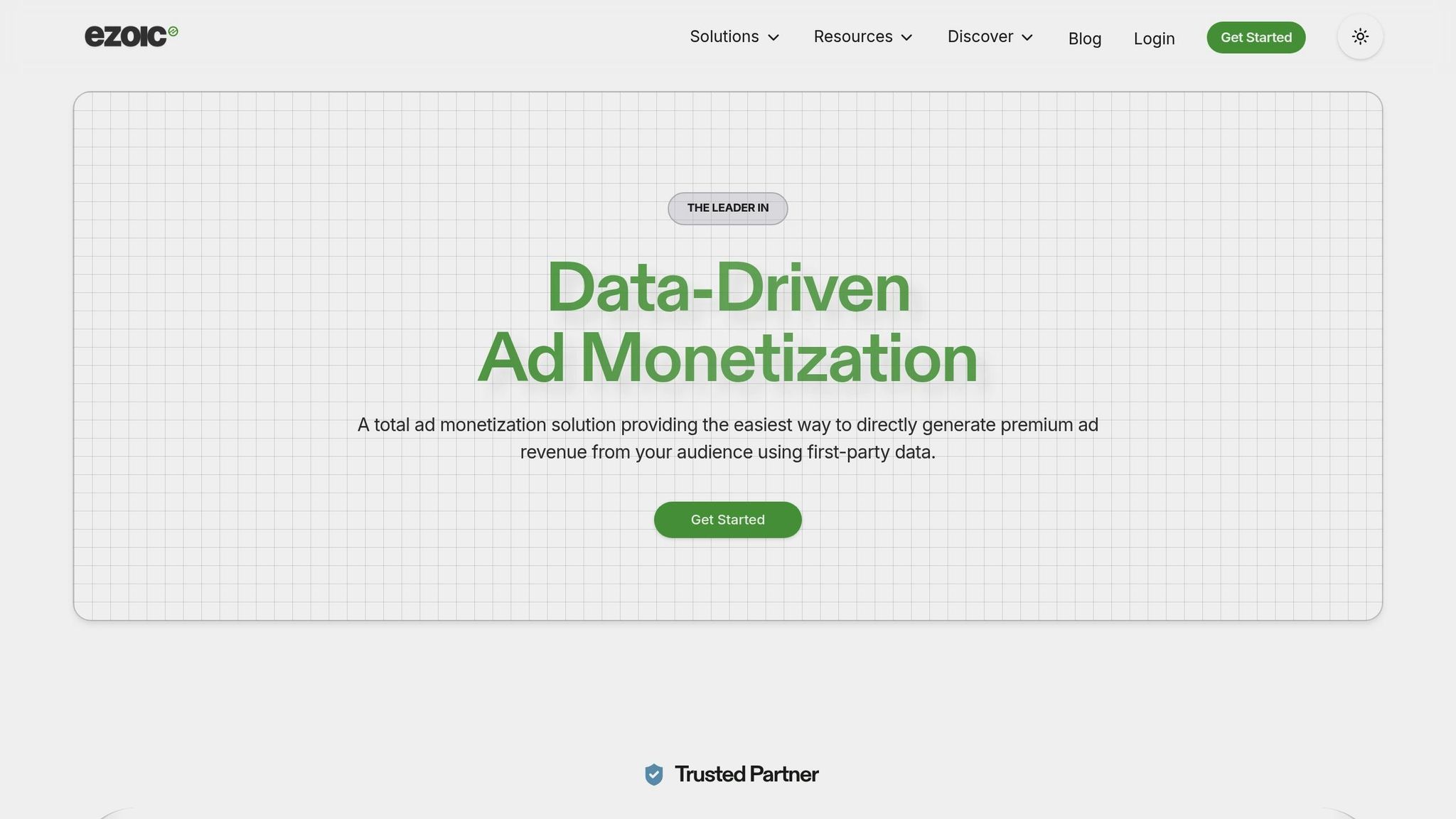
Ezoic is an AI-powered platform designed to automatically optimize ad placements and website performance using machine learning. Its system continuously tests various ad combinations to find the most effective setup for each visitor, taking the trial-and-error out of ad management. For publishers, this can translate into notable revenue growth without the hassle of manual adjustments.
Ezoic operates on a tiered system, grouping publishers based on their annual revenue. The platform prioritizes both revenue growth and user experience, giving publishers the flexibility to choose strategies that align with their goals.
Revenue Potential
Ezoic offers a promising earning potential, with publishers reportedly making $40–$60 per 1,000 page views. In fact, some publishers have seen revenue increases of up to 50% in just 30 days. A case study from May 2024 highlights how RPM improvements and better ad viewability led to significant earnings gains.
Take, for example, a history-focused niche site with 1.1 million monthly visits. After partnering with Ezoic and integrating header bidding technology alongside Google Ad Exchange, the site’s monthly earnings skyrocketed from $7,764 (using AdSense only) to $27,005 within two months. Here’s how the numbers broke down:
- Page RPM jumped by 237%, from $5.81 to $19.60.
- Impression RPM increased by 185%, from $1.54 to $4.39.
- Ad viewability improved significantly, rising from 60.57% to 84.7%.
- Video ad revenue saw an additional monthly boost of $5,900 through Humix.
Traffic Requirements
Ezoic is accessible to publishers at almost any stage of growth. Unlike some platforms, it doesn’t impose strict pageview limits for new sign-ups. For smaller publishers, Ezoic offers an "Access Now" program tailored to sites with fewer than 10,000 monthly page views. While Ezoic recommends at least 1,000 visits per month for best results, this low entry threshold makes it a great option for smaller publishers - especially considering that one in three publisher websites earns no revenue from monetization efforts.
Ad Customization
Ezoic takes ad customization to the next level with AI-driven multivariate testing. Tools like Ad Tester and Leap analyze audience segments - such as location, device type, and browsing behavior - to determine the best ad layouts. Most publishers find success using the "Balanced" setting for day-to-day operations, switching to "Revenue Focused" during high-traffic periods. This personalized approach not only enhances user experience but also maximizes revenue potential.
Reporting and Analytics
Ezoic’s analytics tools empower publishers to make smarter, data-driven decisions. Through its Big Data Analytics platform, publishers gain a detailed view of their site’s performance across numerous metrics. One standout feature is the ability to compare an Ezoic-optimized site against its original version, clearly demonstrating the platform’s impact. The dashboard also provides insights into visitor demographics, behavior, and content performance, helping publishers refine their strategies.
The results speak for themselves. For instance, ChromeUnboxed.com saw a 152% revenue increase after implementing Ezoic in 2023. Similarly, BroadwayWorld CEO Robert Diamond reported a 30% rise in RPS (ePMV) within 30 days, along with a 25% boost in user engagement.
"With Ezoic, we have a partner that actually helped us take a more data-driven approach with our efforts. The platform has helped leverage our data to improve experiences and increase user value." – Robert Diamond, CEO, Founder, BroadwayWorld
Ezoic also offers a "Revenue Issues" tool that flags potential configurations affecting earnings. However, publishers should weigh the impact on user experience before making changes. Additionally, the platform’s caching system plays a vital role in maintaining site speed. Publishers are encouraged to aim for high "Cache Hits" and minimize "Cache Misses" to ensure optimal performance.
sbb-itb-957fd63
4. AdThrive
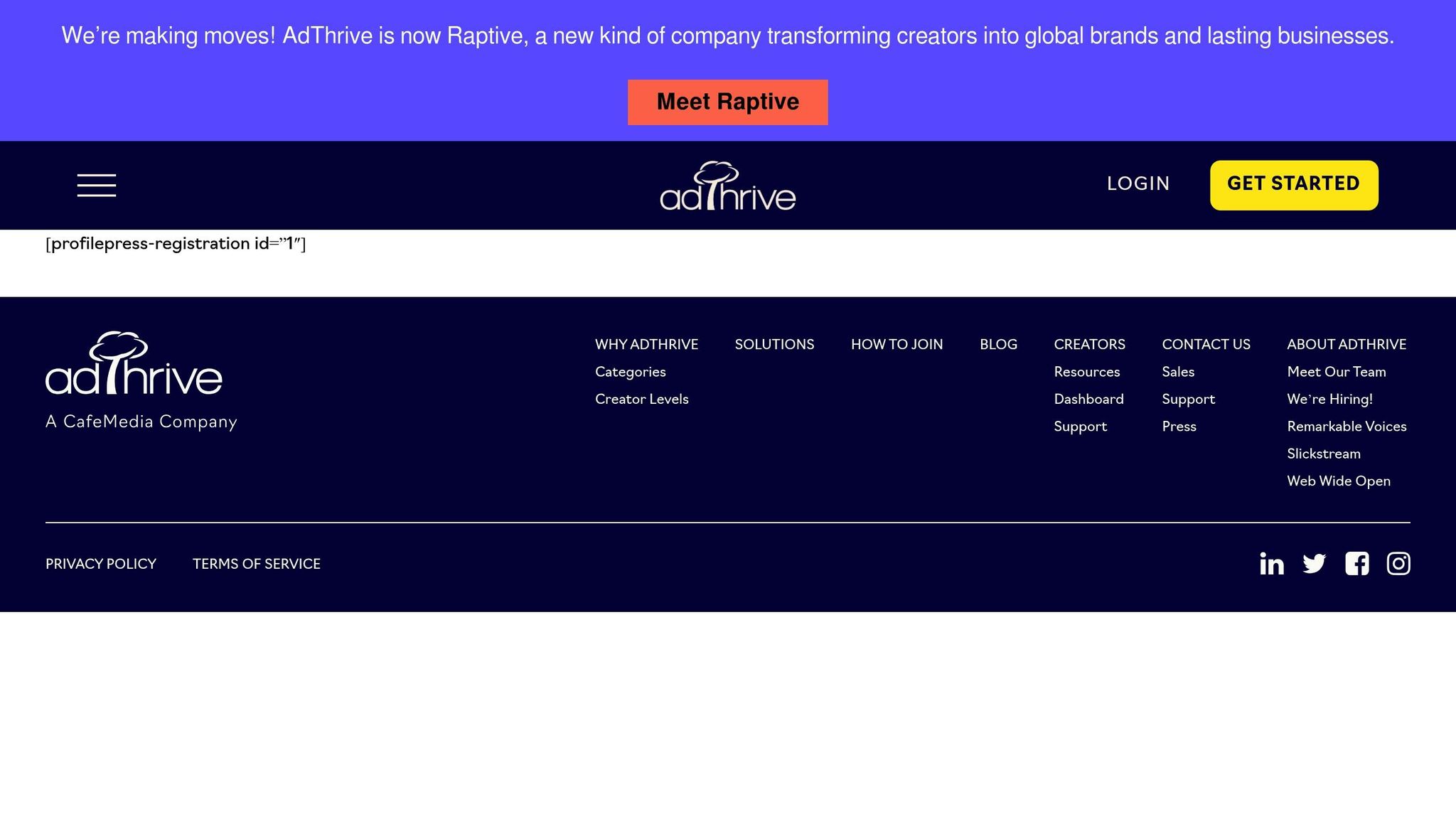
AdThrive, now rebranded as Raptive, caters to high-traffic publishers seeking premium ad placements and personalized strategies. Known for its hands-on approach, the platform prioritizes maximizing revenue with targeted ad placements tailored to each publisher's needs. With dedicated account managers and advanced performance insights, AdThrive goes beyond basic ad-serving solutions to deliver a more customized experience.
Traffic Requirements
To join AdThrive, publishers must meet some of the highest entry standards in the industry. The platform requires a minimum of 100,000 monthly page views, setting it apart as a service designed for established, high-traffic sites. Additionally, publishers need a significant portion of their traffic to come from tier-one countries like the United States, the United Kingdom, Canada, Australia, or New Zealand.
This high threshold ensures that AdThrive focuses on premium publishers. While the exclusivity might limit access for smaller sites, those who qualify often benefit from higher earning potential and more tailored support.
"I determined that AdThrive is the best because it only works with high-traffic sites like mine (100k+ monthly visits)." - David Nahmani, Author and Owner, Logic Pro Help
Revenue Potential
AdThrive is known for delivering some of the highest CPMs in the industry, with fill rates exceeding 90% and RPMs typically ranging from $15 to $40. These figures reflect the platform's focus on premium ad placements and audience targeting. Depending on the publisher's niche and audience quality, many report even higher returns.
One standout feature is AdThrive's payment guarantee, which ensures publishers are paid on time, even if advertisers face delays. This reliable cash flow is a major advantage for publishers running ad-supported businesses.
As a Google Certified Advertising Partner, AdThrive provides access to premium demand sources unavailable to smaller networks. This status, combined with flexible ad format options, often leads to significant revenue increases for publishers compared to other platforms.
Ad Customization
AdThrive offers publishers a high degree of control over their ad strategies. Through the Ad Preferences tab, publishers can manually adjust ad categories to ensure alignment with their brand and audience expectations. For those who prefer less involvement, the platform provides an Auto-Optimize option, where expert teams manage ad strategy adjustments. Even with automation, publishers are kept in the loop and have the final say on major changes.
The platform also creates custom ad layouts tailored to each publisher. These layouts consider factors like site design, traffic data, viewability metrics, and current ad performance. AdThrive supports a variety of ad formats, including interstitial ads, mobile ads, native ads, and video ads. To maintain a balance between user experience and revenue, AdThrive enforces a strict 30% ad density policy.
Reporting and Analytics
AdThrive complements its personalized ad strategies with detailed performance insights and regular consultations. Publishers receive analytics on metrics like viewability, user engagement, and revenue, helping them understand the effectiveness of their strategies. These insights go beyond numbers, offering explanations for why certain approaches work better than others.
Dedicated account managers conduct regular performance reviews, analyzing site performance and providing recommendations for improvement. These consultations help publishers adapt to changing traffic patterns, seasonal trends, and shifts in the industry, ensuring their ad strategies remain effective over time.
Platform Comparison: Benefits and Drawbacks
Choosing the right ad platform depends on your niche and traffic profile. Below is a breakdown of key platforms, highlighting their strengths and potential challenges.
TinyAdz is a great option for small publishers due to its open-door policy - there are no minimum traffic requirements. It connects niche audiences with relevant advertisers and goes beyond standard banner ads, offering monetization options like social media, newsletters, and events.
Media.net specializes in contextual advertising, focusing on delivering ads that align closely with your site's content. It performs particularly well with quality traffic from tier-one, English-speaking countries, ensuring better ad relevance.
Ezoic is ideal for publishers who want more control over their ad strategy. It uses AI-driven tools to optimize performance and offers robust analytics. However, the self-serve nature of the platform means you may need to navigate occasional dashboard or support challenges. Despite this, its competitive 10% revenue share makes it appealing.
AdThrive caters to high-traffic publishers, requiring at least 100,000 monthly page views. It offers a premium, hands-off experience with dedicated account managers handling optimization. This allows publishers to focus solely on creating content while benefiting from some of the highest revenue returns in the industry.
| Platform | Revenue Potential | Traffic Requirements | Ad Customization | Reporting and Analytics |
|---|---|---|---|---|
| TinyAdz | Targeted niche revenue | No minimum required | Banner, social media, newsletter, events | Clear and straightforward reporting dashboard |
| Media.net | Contextual ad premiums | Quality traffic from tier-1 countries | Sizeless ads with native integration | User-friendly reporting tools |
| Ezoic | $20–25 RPM average | No minimum required | AI-driven A/B testing and layout optimization | Comprehensive self-serve dashboard |
| AdThrive | High revenue potential | 100,000+ monthly page views | Custom ad layouts | Dedicated account management |
For niche publishers, the decision often hinges on traffic volume and content focus. Platforms like TinyAdz or Ezoic are excellent for smaller sites looking to grow gradually, while larger, established publishers may find AdThrive's premium services more rewarding.
Your management preferences also play a role. Ezoic offers hands-on customization, AdThrive takes care of optimization for you, and Media.net provides a middle ground with balanced support and automation.
Conclusion
When selecting a monetization platform, it's essential to consider your website's traffic, niche, and how you prefer to manage your monetization efforts. Different platforms cater to various stages of publisher growth, offering tools and strategies that align with specific needs.
The reality is stark: 1 in 3 publisher websites earns nothing from their efforts. This highlights the importance of finding a platform that suits your situation. For those just starting out or with limited traffic, platforms with no minimum traffic requirements and competitive revenue share models are a great starting point. As your site grows, you'll want to collaborate with networks that prioritize quality - this often means creating original content and attracting traffic from English-speaking regions.
Your management style also plays a role in this decision. Some platforms offer AI-powered tools for automation, while others provide dedicated account support. Payment thresholds vary as well - AdSense, for example, requires a $100 minimum payout, but other networks may offer lower thresholds, making them more accessible for smaller publishers.
The online advertising landscape is shifting. Nonvideo display ads are expected to decline from 54% in 2020 to 36.2% by 2026. To stay ahead, consider networks that support video ads or dynamic formats, ensuring your strategy remains relevant in the years to come.
Ultimately, start with a platform that matches your current traffic and needs, then scale as your audience grows. Before committing, take the time to review content policies and payment terms to ensure the platform supports your growth goals.
FAQs
What should I consider when selecting a Google AdSense alternative for my website?
When choosing a Google AdSense alternative, it's important to focus on factors that match your website's goals and the preferences of your audience. Start by looking at payment options - does the platform offer methods like PayPal or direct bank transfers? Also, check the minimum payout thresholds to ensure they align with what works for you.
Next, consider the ad quality and how relevant the ads are to your visitors. Platforms often use different revenue models, such as CPM (cost per thousand impressions), CPC (cost per click), or CPA (cost per action). Understanding these can help you pick one that suits your monetization strategy.
Another critical factor is the platform's traffic requirements and whether it caters to your niche. A platform that aligns with your site's content and audience is more likely to boost your earnings while keeping the user experience intact. Finally, look for options that are simple to integrate and offer robust reporting tools, so you can easily track and optimize your performance.
What are the traffic requirements for the ad platforms discussed in the article?
Traffic thresholds differ depending on the platform:
- Media.net: Requires at least 10,000 monthly pageviews.
- Ezoic: Has no minimum traffic requirement.
- AdThrive: Sets a higher bar with a requirement of 100,000 monthly pageviews.
- Mediavine: Looks for 50,000 sessions per month.
Platforms like AdPushup and SmartyAds also don't enforce minimum traffic requirements in the U.S. It's important to assess these benchmarks in the context of your site's current performance and future growth.
What are the main benefits of using AI-powered platforms like Ezoic for ad optimization?
AI-driven platforms like Ezoic provide publishers with several key advantages when it comes to maximizing ad revenue:
- Smart testing: Ezoic’s AI conducts multivariate tests to determine the best ad placements for optimal performance.
- Tailored ad experiences: The platform customizes ad placement based on how visitors interact with your site, leading to better engagement and satisfaction.
- Dynamic adjustments: Ads are resized and repositioned in real-time to create a smoother experience for users while boosting revenue.
- Learning and adapting: Ezoic’s AI continuously evolves, keeping up with audience behavior and trends to ensure your monetization strategy stays effective.
With these tools, publishers can streamline ad management while enhancing both their site's user experience and revenue outcomes.

